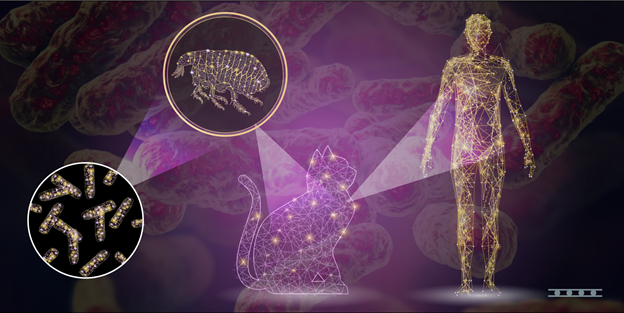What is Bartonellosis?
Bartonellosis is an infectious disease caused by Bartonella species, bacteria with a thin cell wall, called gram-negative, that can live and reproduce outside of the host (humans or animals). [1] These bacteria are commonly implicated in causing many emerging and re-emerging zoonotic (transferred from animals to humans) infections globally. [2] They are usually transmitted by blood-feeding insects like sandflies, human body lice, feline fleas, and/or animal scratches and bites. [2] It is the only group of bacteria belonging to thefamily. The typical medical textbook will likely only describe the three most common Bartonella species (and the infections they cause): Bartonella henselae (Cat Scratch Disease), Bartonella quintana (Trench fever), and Bartonella bacilliformis (Oroya fever); however, since the first documented cases for Bartonella bacilliformis in 1870, there are almost 20 different species of Bartonella that have been isolated. [1,2,3]
How prevalent is Bartonellosis?
The most common form of “Bartonellosis” comes from B. henselae, which causes “Cat Scratch Disease” (CSD). [1] Signs and symptoms of CSD include low-grade fever, enlarged, tender lymph nodes that develop 1-3 weeks after exposure, and a rash and/or pustule at the site of the scratch. [4] Per its unique name, cats are known as the primary reservoir for B. henselae, accidentally transmitting to humans, dogs, horses, and marine animals; however, dogs and other mammals (especially humans) can also serve as a vector for the pathogen. The carrier rate for B. henselae in asymptomatic individuals ranges from 10% to 30%. The worldwide incidence of CSD is approximately 6 cases per 100,000 population in adults and 9 cases per 100,000 population in children aged 5-9 years. [1] The highest incidence is reported in the southeastern United States with a peak in January, late summer, and fall. [5]
B. quintana (Trench fever) and B. bacilliformis (Oroya fever) are the other most common Bartonella species causing Bartonellosis. Trench fever is associated with frequent fevers, lasting 1–3 days and headaches, shin pain, and dizziness, which can recur every 4–6 days. [7,8,9] B. quintana is transmitted by the human body louse, Pediculus humanus corporis. These lice are typically found within the fabric of clothing and bedding are usually associated with poverty, lack of hygiene, and cold weather. [8] As such, Trench fever is more prevalent among the homeless population because they are more frequently exposed to the bacteria. Additionally, a study examining homeless patients receiving clinic care in downtown Seattle showed that 25% of the homeless population were positive for a past Bartonella infection compared with only 2% in a non-homeless population. [10,11]
B. bacilliformis, formerly known as “South American bartonellosis”, is transmitted by bites from infected sand flies and usually occurs in western South America (particularly the Andes’ mountain region of Peru). [12,13] This form of bartonellosis causes a rare infection with two distinct phases: 1) early phase Oroya fever, initially characterized by fever, headache, muscle aches, abdominal pain, and severe anemia, and later by complications like heart failure, pulmonary edema, and cardiogenic shock and 2) late phase Verruga peruana (Peruvian warts). [13,14] However, despite being an ancient disease, research is limited, and much is still unknown about which animals may be a part of the natural cycle of this disease. [13,14]
How do we diagnosis Bartonellosis?
There is no gold standard for diagnosing Bartonella infection – the diagnostic modalities commonly used include a combination of serological testing, culture collection, histopathology, and polymerase chain reaction (PCR). [1]
Serology testing is considered the best screening test and is usually done via indirect fluorescent assay (IFA) or enzyme-linked immunosorbent assay (ELISA). [1,4]
A positive bacteria culture is a definitive diagnosis. However, Bartonella is a slow-growing bacteria, with culture incubation periods up to 21 days and detection of colonies after 1 to 4 weeks of incubation on blood agar plates. [1,4] Histopathological (microscopic) examination of the tissue infected by Bartonella species requires trained professionals to confirm a Bartonella infection. [1]
Advanced diagnostic techniques, such as PCR on lymph nodes, have been also applied to the detection of Bartonella. [1] PCR in blood, CSF or lymph nodes provides the advantages of high specificity and rapid identification; however, PCR sensitivity decreases as time from initial infection increases (ranging from 43% to 76%). [1,4,15]
Can Bartonellosis be treated?
Because Bartonellosis is a bacterial infection, generally antibiotics are used for treatment. Interestingly, CSD typically does not respond to antibiotic therapy. [1,16] Local infections are typically self-limiting and resolve without treatment. [1,4,16] However, some studies have shown that certain antibiotics may reduce duration of symptoms. [1,6] Specifically, azithromycin has been shown to decrease lymphadenitis more rapidly than without treatment. [4] However, infection with B. quintana and B. bacilliformis typically requires antibiotic treatment. Several antibiotics have shown to be effective against Bartonellosis (e.g. penicillins, tetracyclines, cephalosporins, and aminoglycosides). [12,17] At times, more than one antibiotic can be used. However, the type of antibiotic and its dosage should be discussed with a healthcare provider prior to use.
Takeaway points: How do we prevent Bartonellosis?
There are a few preventions that one can do.
- General hygiene (access to regular showers and laundry services) can help to limit exposure to human body lice. [17]
- Washing clothes or bedding that may be infested with body lice, use hot water above 55 degrees Celsius (130 degrees Fahrenheit) and dry on high heat to kill lice and their eggs. [17]
- Use of EPA-registered insect repellents and wear long-sleeved shirts and long pants to avoid sand fly bites in areas where bacilliformis is common (South America). If possible, limit outdoor activities at dawn and dusk, when sand flies are most active. [12]
- Wash hands immediately after handling any cats; avoid cat scratches, bites, and licks, especially from kittens or stray cats. This is particularly critical for people who have weakened immune systems. [4]
References
- Mada PK, Zulfiqar H, Joel Chandranesan AS. Bartonellosis. [Updated 2022 May 1]. In: StatPearls [Internet]. Treasure Island (FL): StatPearls Publishing; 2022 Jan-. Available from: https://www.ncbi.nlm.nih.gov/books/NBK430874/
- Angelakis, E. and Raoult, D., 2014. Pathogenicity and treatment of Bartonella infections. International Journal of Antimicrobial Agents, 44(1), pp.16-25.
- Spach, D.H. (2021). Basic biology of Bartonella species. In. T.W. Post, S.B. Calderwood, & K.K. Hall (Eds.), UpToDate. Available from https://www.uptodate.com/contents/basic-biology-of-bartonella-species?search=Bartonella&source=search_result&selectedTitle=3~105&usage_type=default&display_rank=3
- Center for Disease Control and Prevention. n.d. Bartonella henselae infection or cat scratch disease (CSD). [online] Available at: https://www.cdc.gov/bartonella/bartonella-henselae/index.html.
- Nelson CA, Moore AR, Perea AE, Mead PS. Cat scratch disease: U.S. clinicians’ experience and knowledge. Zoonoses Public Health. 2018 Feb;65(1):67-73. doi: 10.1111/zph.12368. Epub 2017 Jul 14. PMID: 28707827.
- Hill, D., Ryan, E., Solomon, T., Aronson, N. and Endy, T., 2020. Hunter’s Tropical Medicine and Emerging Infectious Diseases (Tenth Edition). 10th ed. Elsevier, pp.602-603.
- Ohl, M. and Spach, D., 2000. Bartonella quintana and Urban Trench Fever. Clinical Infectious Diseases, 31(1), pp.131-135.
- Foucault, C., Brouqui, P. and Raoult, D., 2006. Bartonella quintana Characteristics and Clinical Management. Emerging Infectious Diseases, 12(2), pp.217-223.
- Karem, K., Paddock, C. and Regnery, R., 2000. Bartonella henselae, B. quintana, and B. bacilliformis: historical pathogens of emerging significance. Microbes and Infection, 2(10), pp.1193-1205.
- Guibal, F., de La Salmonire, P., Rybojad, M., Hadjrabia, S., Dehen, L. and Arlet, G., 2001. High seroprevalence to Bartonella quintana in homeless patients with cutaneous parasitic infestations in downtown Paris. Journal of the American Academy of Dermatology, 44(2), pp.219-223.
- Jackson LA, Spach DH, Kippen DA, Sugg NK, Regnery RL, Sayers MH, et al. Seroprevalence to Bartonella quintana among patients at a community clinic in downtown Seattle. J Infect Dis 1996; 173:1023-6
- Center for Disease Control and Prevention. n.d. Bartonella bacilliformis infection. [online] Available at: <https://www.cdc.gov/bartonella/bartonella-bacilliformis/index.html>.
- Maguiña, C. and Gotuzzo, E., 2000. Bartonellosis: new and old. Infectious disease clinics of North America, 14(1), pp.1-22.
- Sanchez Clemente, N., Ugarte-Gil, C.A., Solórzano, N., Maguiña, C., Pachas, P., Blazes, D., Bailey, R., Mabey, D. and Moore, D., 2012. Bartonella bacilliformis: a systematic review of the literature to guide the research agenda for elimination. PLoS neglected tropical diseases, 6(10), p.e1819.
- com. 2021. Bartonella Infection | Choose the Right Test. [online] Available at: <https://arupconsult.com/content/bartonella-species>.
- Angelakis, E. and Raoult, D., 2014. Pathogenicity and treatment of Bartonella infections. International Journal of Antimicrobial Agents, 44(1), pp.16-25.
- Center for Disease Control and Prevention. n.d. Bartonella quintana infection. [online] Available at: <https://www.cdc.gov/bartonella/bartonella-quintana/index.html>





